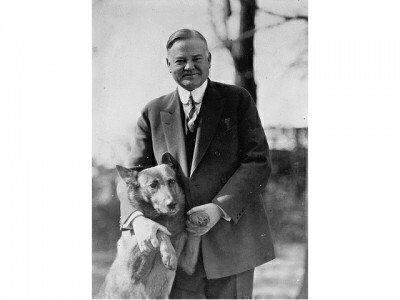The 12th annual National Dog Day is getting a lot of attention on social media, and in the spirit of the pseudo-holiday, Constitution Daily looks back as a few canines who had an impact on the American political scene.

It's well-known that almost every President, with the exception of Andrew Johnson, had some type of pet. And dogs have been among the best-known companions to the residents of the White House.
President Franklin Roosevelt's dog Fala wound up playing a role in FDR's 1944 re-election campaign. Herbert Hoover used his dog, King Tut, as an election campaign companion. And most of us know about Checkers the dog and Richard Nixon. Here's a quick look at some of the most famous First Dogs!
Even before he became President, George Washington made it clear he was a dog lover. Some speculate that Washington’s act of kindness toward a dog might have changed the early course of the Revolution.
In October 1777, at the Battle of Germantown (a few miles north of the National Constitution Center), General George Washington found a dog wandering the front lines after the battle ended.
A huge dog lover, Washington checked the dog’s collar and found its owner was the enemy commander, British General William Howe. Washington’s troops wanted to keep the dog as a war trophy. The commander wouldn’t hear of it and he summoned his top aide, Alexander Hamilton, to call a truce so the dog could be returned to Howe.
A grateful Howe thanked Washington and there are theories the incident changed his impression about Washington and Americans in general. Howe returned to London the next year after receiving criticism for staying in Philadelphia too long and not aggressively fighting the Colonial forces. While this might seem like a tall tale, Washington’s note to Howe still exists (in Alexander Hamilton’s handwriting) and can be seen online at the National Archives.
In his public career, Washington had as many as 30 dogs. He even created a breed, the American Foxhound.
It was Herbert Hoover, Coolidge’s successor, who put presidential pets in the political spotlight. Hoover actively campaigned with King Tut, his Belgian shepherd. King Tut actually went out on tour with Hoover and his picture was sent to thousands of voters, in an effort to soften Hoover’s image. Hoover won in a landslide. But it was two other dogs that changed the course of elections in 1944 and 1952 that many people remember as political pawns.
During his third presidential term, Franklin D. Roosevelt struggled with GOP opponent Thomas Dewey, until Republicans criticized FDR’s Scottish terrier, Fala. The GOP alleged Roosevelt left the dog behind by accident in Alaska and sent a warship, at great taxpayer expense, to retrieve Fala.
In September 1944, Roosevelt’s “Fala" speech showcased his skills as an orator and convinced voters that he was vital and healthy enough for a fourth term. “These Republican leaders have not been content with the attacks on me, or my wife, or on my sons. No, not content with that, they now include my little dog. Fala,” Roosevelt said. “I am accustomed to hearing malicious falsehoods about myself—such as that old, worm-eaten chestnut that I have represented myself as indispensable. But I think I have a right to resent, to object, to libelous statements about my dog!”
Richard Nixon used his own dog speech to rescue his spot on the 1952 presidential ticket. Nixon had been accused of taking money from supporters to finance an election fund for his future 1956 Senate campaign. The Democrats demanded Nixon quit the race in September 1952, and his running mate, Dwight Eisenhower, was considering dropping Nixon from the ticket.
In the equally famous "Checkers" speech, Nixon told a nationwide television audience of 60 million viewers that he didn’t use the money for personal expenses. But he wouldn’t return one campaign gift. “It was a little cocker spaniel dog in a crate that he'd sent all the way from Texas. … And our little girl—Tricia, the 6-year-old—named it Checkers. And you know, the kids, like all kids, love the dog and I just want to say this right now, that regardless of what they say about it, we're gonna keep it,” Nixon said.
Phone calls flooded Republican headquarters to support Nixon, and Eisenhower kept him on the ticket.
Since Fala and Checkers, presidential pets have been elevated to almost a cabinet-level position.
George H. W. Bush’s dog, Millie, received the semi-official title of First Dog, and even authored a book (along with a ghost writer). Socks the cat represented the Clintons in office, while George W. Bush’s dog, Barney, starred in annual videos for the media.
Bill Clinton’s other pet, Buddy the dog, died in 2002 when he was run over by car in Chappaqua, New York. Buddy was being watched by Secret Service agents (the former president was away at the time), who lost track of the dog. Clinton later acquired a chocolate lab named Seamus as Buddy's successor.
Currently, President Barack Obama has two Portuguese water dogs, Bo and Sunny.






